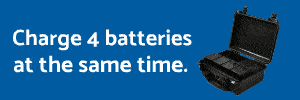- Joined
- Dec 13, 2015
- Messages
- 931
- Reaction score
- 498
- Age
- 76
This topic was discussed many times here and on other forums, and still remains confusing to many. Since my aerial photography and filming is almost exclusively done in remote landscapes, this issue is of paramount importance. Here are my thoughts, based on real life experience.
Field battery charging is - unfortunately - more complicated than most of us will expect. The reason? Power supply. You need a plenty of stored or fabricated energy available out there. Relatively small, single Phantom or Mavic battery can be charged off a car cigarette lighter or auxiliary output, assuming good shape of vehicle power plant, socket, internal wiring and fusing. DJI's offering suitable chargers for such. However, try to charge more than once or twice without re-conditioning car battery and you may end up looking for a good people with booster cable next morning.
Still, for recreational use this approach may be good enough. For Inspire/Matrice class drones, however, intensive filming in remote locations requires reliable power source. The obvious and simple solution is a generator, 2000W Honda as being the most loved by pros. Add an multichannel charger to feed 4 batteries simultaneously, sufficient number of spare batteries and you're happy. flying without interruptions other than for lunch break.
Than we have solutions for brave ones: huge 12V battery and 1000 or 2000W inverter in the trunk as an equivalent of a noisy and smelly generator. 200Ah led battery weights 60-70kG, but - when fully charged - will provide enough juice to charge several TB48's or TB47's. This approach, however, carry a serious safety issues. Heavy wiring aside, such monstrous load must be securely mounted and isolated, avoiding the risk of catastrophic shorts. Not cheap though.

Here's similar, but cheaper solution, in testing shape. Equally challenging, however, for a few of us only familiar with soldering gun. Huge storage battery is still required, but the charging voltage and current is provided by widely e-Bay available DC-DC Step-Up Converters. In this scenario power is drained from 24 V battery bank with approx. 11.5 A total current, while each Inspire battery drains approx. 5 A charging current. Therefore only 1.5 A is used for voltage conversion, not bad at all. One may want to crank the charging current up a bit, but the benefits are negligible with 5 or so minutes less gain. Here two batteries depleted to 15% were charged in 63 minutes.

Here's a DIY double channel charger for 12 V source, set up for Phantom 3 batteries with moderate charging rate. Note approx. 4.5A charging current for each battery, but the total drain is about 15A! The wiring from battery terminals must be at least of 10AWG to avoid noticeable voltage drop. Converters itself are of CV/CC type (Constant Voltage/Constant Current). allowing for wide output parameters adjustment to charge Inspire batteries as well. In this case, however, the drain is even bigger, reaching 20-25 A current with 12 V source. Naturally 24 V battery will provide much better configuration, but this option may be available for some truckers and boaters only.
Bottom line: drone batteries are hogs and will demand a lot of power. A portable generator is still the best, simple and safe ...
Field battery charging is - unfortunately - more complicated than most of us will expect. The reason? Power supply. You need a plenty of stored or fabricated energy available out there. Relatively small, single Phantom or Mavic battery can be charged off a car cigarette lighter or auxiliary output, assuming good shape of vehicle power plant, socket, internal wiring and fusing. DJI's offering suitable chargers for such. However, try to charge more than once or twice without re-conditioning car battery and you may end up looking for a good people with booster cable next morning.
Still, for recreational use this approach may be good enough. For Inspire/Matrice class drones, however, intensive filming in remote locations requires reliable power source. The obvious and simple solution is a generator, 2000W Honda as being the most loved by pros. Add an multichannel charger to feed 4 batteries simultaneously, sufficient number of spare batteries and you're happy. flying without interruptions other than for lunch break.
Than we have solutions for brave ones: huge 12V battery and 1000 or 2000W inverter in the trunk as an equivalent of a noisy and smelly generator. 200Ah led battery weights 60-70kG, but - when fully charged - will provide enough juice to charge several TB48's or TB47's. This approach, however, carry a serious safety issues. Heavy wiring aside, such monstrous load must be securely mounted and isolated, avoiding the risk of catastrophic shorts. Not cheap though.

Here's similar, but cheaper solution, in testing shape. Equally challenging, however, for a few of us only familiar with soldering gun. Huge storage battery is still required, but the charging voltage and current is provided by widely e-Bay available DC-DC Step-Up Converters. In this scenario power is drained from 24 V battery bank with approx. 11.5 A total current, while each Inspire battery drains approx. 5 A charging current. Therefore only 1.5 A is used for voltage conversion, not bad at all. One may want to crank the charging current up a bit, but the benefits are negligible with 5 or so minutes less gain. Here two batteries depleted to 15% were charged in 63 minutes.

Here's a DIY double channel charger for 12 V source, set up for Phantom 3 batteries with moderate charging rate. Note approx. 4.5A charging current for each battery, but the total drain is about 15A! The wiring from battery terminals must be at least of 10AWG to avoid noticeable voltage drop. Converters itself are of CV/CC type (Constant Voltage/Constant Current). allowing for wide output parameters adjustment to charge Inspire batteries as well. In this case, however, the drain is even bigger, reaching 20-25 A current with 12 V source. Naturally 24 V battery will provide much better configuration, but this option may be available for some truckers and boaters only.
Bottom line: drone batteries are hogs and will demand a lot of power. A portable generator is still the best, simple and safe ...
Last edited:






